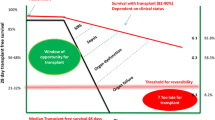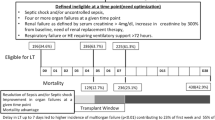Abstract
Purpose of Review
Patients with end-stage chronic liver disease (CLD) frequently deteriorate with development of a ‘frail’ state and progress to development of extra-hepatic organ failures. Making the clinical judgement when a patient is ‘too sick’ to proceed with liver transplantation is challenging; we summarise recent studies that may inform decision-making.
Recent Findings
Reports quantify the impact of both recipient and donor factors related to early post-transplant survival, with consistent adverse association of advanced donor and recipient age, under-nutrition, sarcopenia and impaired functional status, and requirement for critical care unit admission and organ support. Survival for ‘very sick’ recipients has shown progressive improvement over time, but evidence is increasing of much greater post-transplant resource use and cost.
Summary
Factors associated with adverse outcomes in very sick recipients are becoming more clearly delineated. The increasing success of transplantation and exploration of its extended use must be tempered by the recognition of the consequences upon constrained clinical resources.





Similar content being viewed by others
References
Papers of particular interest, published recently, have been highlighted as: • Of importance •• Of major Importance
•• Asrani SK, Saracino G, O'Leary JG, et al. Recipient characteristics and morbidity and mortality after liver transplantation. J Hepatol. 2018;15:15. Large national study identifying key recipient factors predictive of post-transplant morbidity and mortality.
•• Bittermann T, Makar G, Goldberg DS. Early post-transplant survival: interaction of MELD score and hospitalization status. J Hepatol. 2015;63(3):601–8. Analysis of UNOS dataset confirming and quantifying impact of hospitalisation on post-transplant outcome.
Wai H, Stepanova M, Saab S, Erario M, Srishord M, Younossi ZM. Inpatient economic and mortality assessment for liver transplantation: a nationwide study of the United States data from 2005 to 2009. Transplantation. 2014;97(1):98–103.
Keswani RN, Ahmed A, Keeffe EB. Older age and liver transplantation: a review. Liver Transpl. 2004;10(8):957–67.
• Sonny A, Kelly D, Hammel JP, Albeldawi M, Zein N, Cywinski JB. Predictors of poor outcome among older liver transplant recipients. Clin Transpl. 2015;29(3):197–203. Single centre analysis of predictors of outcome in elderly recipients
Aloia TA, Knight R, Gaber AO, Ghobrial RM, Goss JA. Analysis of liver transplant outcomes for United Network for Organ Sharing recipients 60 years old or older identifies multiple model for end-stage liver disease-independent prognostic factors. Liver Transpl. 2010;16(8):950–9.
Malinis MF, Chen S, Allore HG, Quagliarello VJ. Outcomes among older adult liver transplantation recipients in the model of end stage liver disease (MELD) era. Ann Transplant. 2014;19:478–87.
Sharpton SR, Feng S, Hameed B, Yao F, Lai JC. Combined effects of recipient age and model for end-stage liver disease score on liver transplantation outcomes. Transplantation. 2014;98(5):557–62.
VanWagner LB, Lapin B, Skaro AI, Lloyd-Jones DM, Rinella ME. Impact of renal impairment on cardiovascular disease mortality after liver transplantation for nonalcoholic steatohepatitis cirrhosis. Liver Int. 2015;35(12):2575–83.
Skaro AI, Gallon LG, Lyuksemburg V, Jay CL, Zhao L, Ladner DP, et al. The impact of coronary artery disease on outcomes after liver transplantation. J Cardiovasc Med (Hagerstown). 2016;17(12):875–85.
Dick AA, Spitzer AL, Seifert CF, et al. Liver transplantation at the extremes of the body mass index. Liver Transpl. 2009;15(8):968–77.
Volk ML, Hernandez JC, Lok AS, Marrero JA. Modified Charlson comorbidity index for predicting survival after liver transplantation. Liver Transpl. 2007;13(11):1515–20.
Cywinski JB, Alster JM, Miller C, Vogt DP, Parker BM. Prediction of intraoperative transfusion requirements during orthotopic liver transplantation and the influence on postoperative patient survival. Anesth Analg. 2014;118(2):428–37.
Kalafateli M, Mantzoukis K, Choi Yau Y, Mohammad AO, Arora S, Rodrigues S, et al. Malnutrition and sarcopenia predict post-liver transplantation outcomes independently of the Model for End-stage Liver Disease score. J Cachexia Sarcopenia Muscle. 2017;8(1):113–21.
•• Lai JC, Dodge JL, Sen S, Covinsky K, Feng S. Functional decline in patients with cirrhosis awaiting liver transplantation: results from the functional assessment in liver transplantation (FrAILT) study. Hepatology. 2016;63(2):574–80. Prospective study documenting functional deterioration of patients on transplant waitlist and association with increased risk of death, independent of MELD score
Lai JC, Feng S, Terrault NA, Lizaola B, Hayssen H, Covinsky K. Frailty predicts waitlist mortality in liver transplant candidates. Am J Transplant. 2014;14(8):1870–9.
Serper M, Bittermann T, Rossi M, et al. Functional status, healthcare utilization, and the costs of liver transplantation. Am J Transplant. 2017;08:08.
• Dasarathy S, Merli M. Sarcopenia from mechanism to diagnosis and treatment in liver disease. J Hepatol. 2016;65(6):1232–44. Comprehensive review of mechanisms and consequences of sarcopenia in chronic liver disease
Tapper EB, Su GL. Does Karnofsky performance status of patients with cirrhosis on the transplant waitlist meet the eyeball test? Clin Gastroenterol Hepatol. 2016;14(8):1196–8.
Jacob M, Copley LP, Lewsey JD, Gimson A, Rela M, van der Meulen J, et al. Functional status of patients before liver transplantation as a predictor of posttransplant mortality. Transplantation. 2005;80(1):52–7.
•• Dolgin NH, Martins PN, Movahedi B, Lapane KL, Anderson FA, Bozorgzadeh A. Functional status predicts postoperative mortality after liver transplantation. Clin Transpl. 2016;30(11):1403–10. Large national study assessing impact of pre-transplant functional status on predictive of post-transplant mortality
Orman ES, Ghabril M, Chalasani N. Poor performance status is associated with increased mortality in patients with cirrhosis. Clin Gastroenterol Hepatol. 2016;14(8):1189–1195.e1.
Lai JC, Volk ML, Strasburg D, Alexander N. Performance-based measures associate with frailty in patients with end-stage liver disease. Transplantation. 2016;100(12):2656–60.
van Vugt JL, Levolger S, de Bruin RW, van Rosmalen J, Metselaar HJ, JN IJ. Systematic review and meta-analysis of the impact of computed tomography-assessed skeletal muscle mass on outcome in patients awaiting or undergoing liver transplantation. Am J Transplant. 2016;16(8):2277–92.
Montano-Loza AJ, Meza-Junco J, Baracos VE, Prado CMM, Ma M, Meeberg G, et al. Severe muscle depletion predicts postoperative length of stay but is not associated with survival after liver transplantation. Liver Transpl. 2014;20(6):640–8.
Valero V 3rd, Amini N, Spolverato G, et al. Sarcopenia adversely impacts postoperative complications following resection or transplantation in patients with primary liver tumors. J Gastrointest Surg. 2015;19(2):272–81.
Wang CW, Feng S, Covinsky KE, Hayssen H, Zhou LQ, Yeh BM, et al. A comparison of muscle function, mass, and quality in liver transplant candidates: results from the functional assessment in liver transplantation study. Transplantation. 2016;100(8):1692–8.
Yadav A, Chang YH, Carpenter S, Silva AC, Rakela J, Aqel BA, et al. Relationship between sarcopenia, six-minute walk distance and health-related quality of life in liver transplant candidates. Clin Transpl. 2015;29(2):134–41.
Wynter-Blyth V, Moorthy K. Prehabilitation: preparing patients for surgery. BMJ. 2017;358:j3702.
Zenith L, Meena N, Ramadi A, Yavari M, Harvey A, Carbonneau M, et al. Eight weeks of exercise training increases aerobic capacity and muscle mass and reduces fatigue in patients with cirrhosis. Clin Gastroenterol Hepatol. 2014;12(11):1920–1926.e2.
Roman E, Garcia-Galceran C, Torrades T, et al. Effects of an exercise programme on functional capacity, body composition and risk of falls in patients with cirrhosis: a randomized clinical trial. PLoS One. 2016;11(3):e0151652.
Sinclair M, Grossmann M, Hoermann R, Angus PW, Gow PJ. Testosterone therapy increases muscle mass in men with cirrhosis and low testosterone: a randomised controlled trial. J Hepatol. 2016;65(5):906–13.
Jacob M, Copley LP, Lewsey JD, Gimson A, Toogood GJ, Rela M, et al. Pretransplant MELD score and post liver transplantation survival in the UK and Ireland. Liver Transpl. 2004;10(7):903–7.
Foxton MR, Al-Freah MA, Portal AJ, et al. Increased model for end-stage liver disease score at the time of liver transplant results in prolonged hospitalization and overall intensive care unit costs. Liver Transpl. 2010;16(5):668–77.
Alexopoulos S, Matsuoka L, Cho Y, Thomas E, Sheikh M, Stapfer M, et al. Outcomes after liver transplantation in patients achieving a model for end-stage liver disease score of 40 or higher. Transplantation. 2013;95(3):507–12.
Moreau R, Jalan R, Gines P, Pavesi M, Angeli P, Cordoba J, et al. Acute-on-chronic liver failure is a distinct syndrome that develops in patients with acute decompensation of cirrhosis. Gastroenterology. 2013;144(7):1426–37. 37.e1–9
Karvellas CJ, Lescot T, Goldberg P, et al. Liver transplantation in the critically ill: a multicenter Canadian retrospective cohort study. Crit Care (London England). 2013;17(1):R28.
Levesque E, Winter A, Noorah Z, Daurès JP, Landais P, Feray C, et al. Impact of acute-on-chronic liver failure on 90-day mortality following a first liver transplantation. Liver Int. 2017;37(5):684–93.
• Putignano A, Gustot T. New concepts in acute-on-chronic liver failure: implications for liver transplantation. Liver Transpl. 2017;23(2):234–43. Review of current status of transplantation of patients with ACLF.
Huebener P, Sterneck MR, Bangert K, et al. Stabilisation of acute-on-chronic liver failure patients before liver transplantation predicts post-transplant survival. Aliment Pharmacol Ther. 2018;02:02.
Montenovo MI, Hansen RN, Dick AAS, Reyes J. Donor age still matters in liver transplant: results from the united network for organ sharing-scientific registry of transplant recipients database. Exp Clin Transplant. 2017;15(5):536–41.
Amin MG, Wolf MP, JA TB Jr, et al. Expanded criteria donor grafts for deceased donor liver transplantation under the MELD system: a decision analysis. [see comment]. Liver Transpl. 2004;10:1468–75. 2004 Dec
Merion RM, Schaubel DE, Dykstra DM, Freeman RB, Port FK, Wolfe RA. The survival benefit of liver transplantation. Am J Transplant. 2005;5(2):307–13.
Maluf DG, Edwards EB, Kauffman HM. Utilization of extended donor criteria liver allograft: is the elevated risk of failure independent of the model for end-stage liver disease score of the recipient? Transplantation. 2006;82(12):1653–7.
Bonney GK, Aldersley MA, Asthana S, Toogood GJ, Pollard SG, Lodge JPA, et al. Donor risk index and MELD interactions in predicting long-term graft survival: a single-centre experience. Transplantation. 2009;87(12):1858–63.
Grat M, Wronka KM, Patkowski W, et al. Effects of donor age and cold ischemia on liver transplantation outcomes according to the severity of recipient status. Dig Dis Sci. 2016;61(2):626–35.
Doyle MB, Vachharajani N, Wellen JR, Anderson CD, Lowell JA, Shenoy S, et al. Short- and long-term outcomes after steatotic liver transplantation. Arch Surg. 2010;145(7):653–60.
Spitzer AL, Lao OB, Dick AA, et al. The biopsied donor liver: incorporating macrosteatosis into high-risk donor assessment. Liver Transpl. 2010;16(7):874–84.
Westerkamp AC, de Boer MT, van den Berg AP, Gouw AS, Porte RJ. Similar outcome after transplantation of moderate macrovesicular steatotic and nonsteatotic livers when the cold ischemia time is kept very short. Transpl Int. 2015;28(3):319–29.
Schlegel A, Linecker M, Kron P, Györi G, de Oliveira ML, Müllhaupt B, et al. Risk assessment in high- and low-MELD liver transplantation. Am J Transplant. 2017;17(4):1050–63.
Bernal W. Improving outcomes for transplantation of critically ill patients with cirrhosis? Clinical Liver Disease. 2017;10(1):25–8.
Author information
Authors and Affiliations
Corresponding author
Ethics declarations
Conflict of Interest
The authors declare that they have no conflict of interest.
Human and Animal Rights and Informed Consent
This article does not contain any studies with human or animal subjects performed by any of the authors.
Additional information
This article is part of the Topical Collection on Liver Transplantation
Rights and permissions
About this article
Cite this article
Singanayagam, A., Bernal, W. Transplantation for the Very Sick Patient—Donor and Recipient Factors. Curr Transpl Rep 5, 199–205 (2018). https://doi.org/10.1007/s40472-018-0197-6
Published:
Issue Date:
DOI: https://doi.org/10.1007/s40472-018-0197-6




